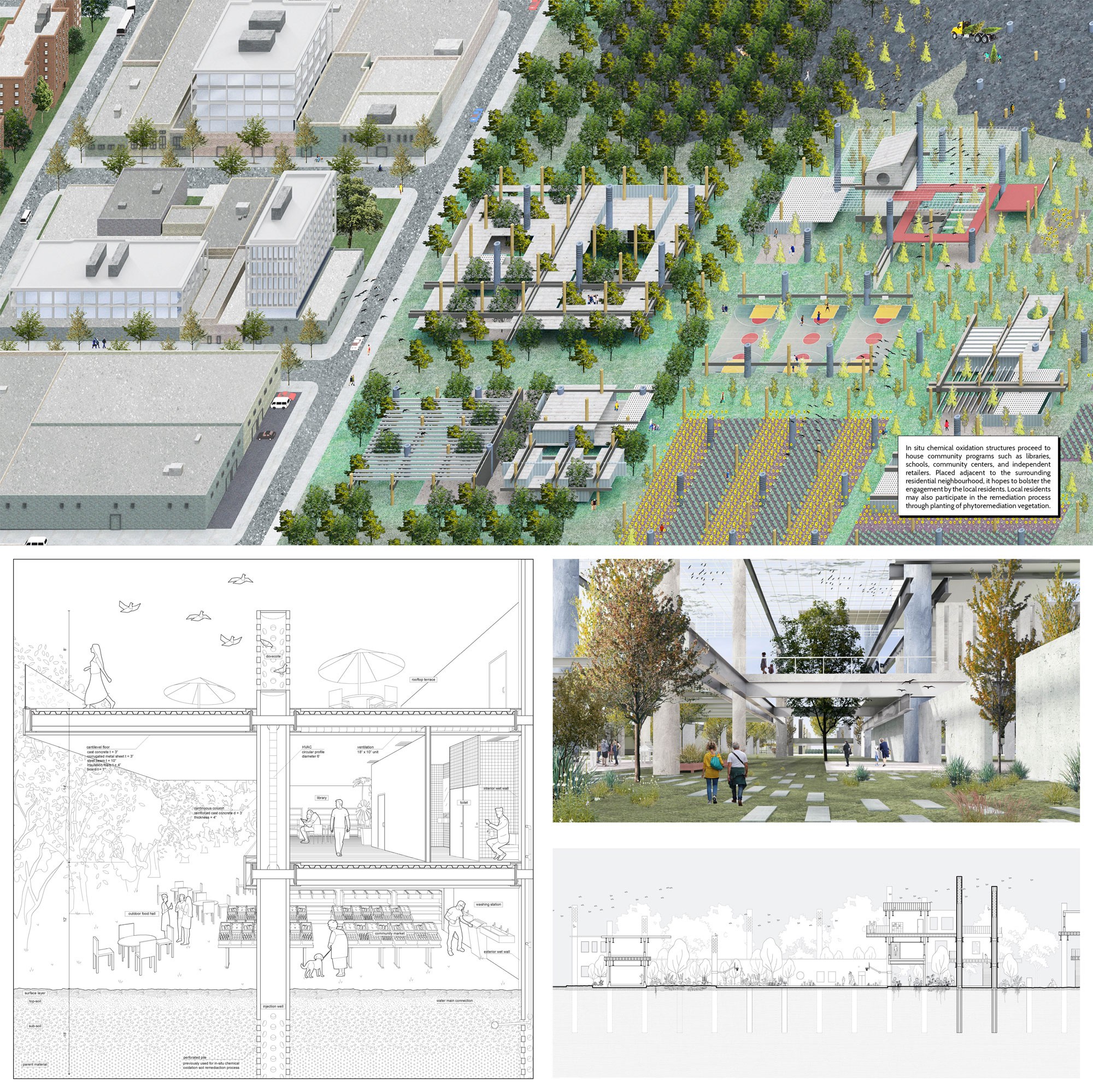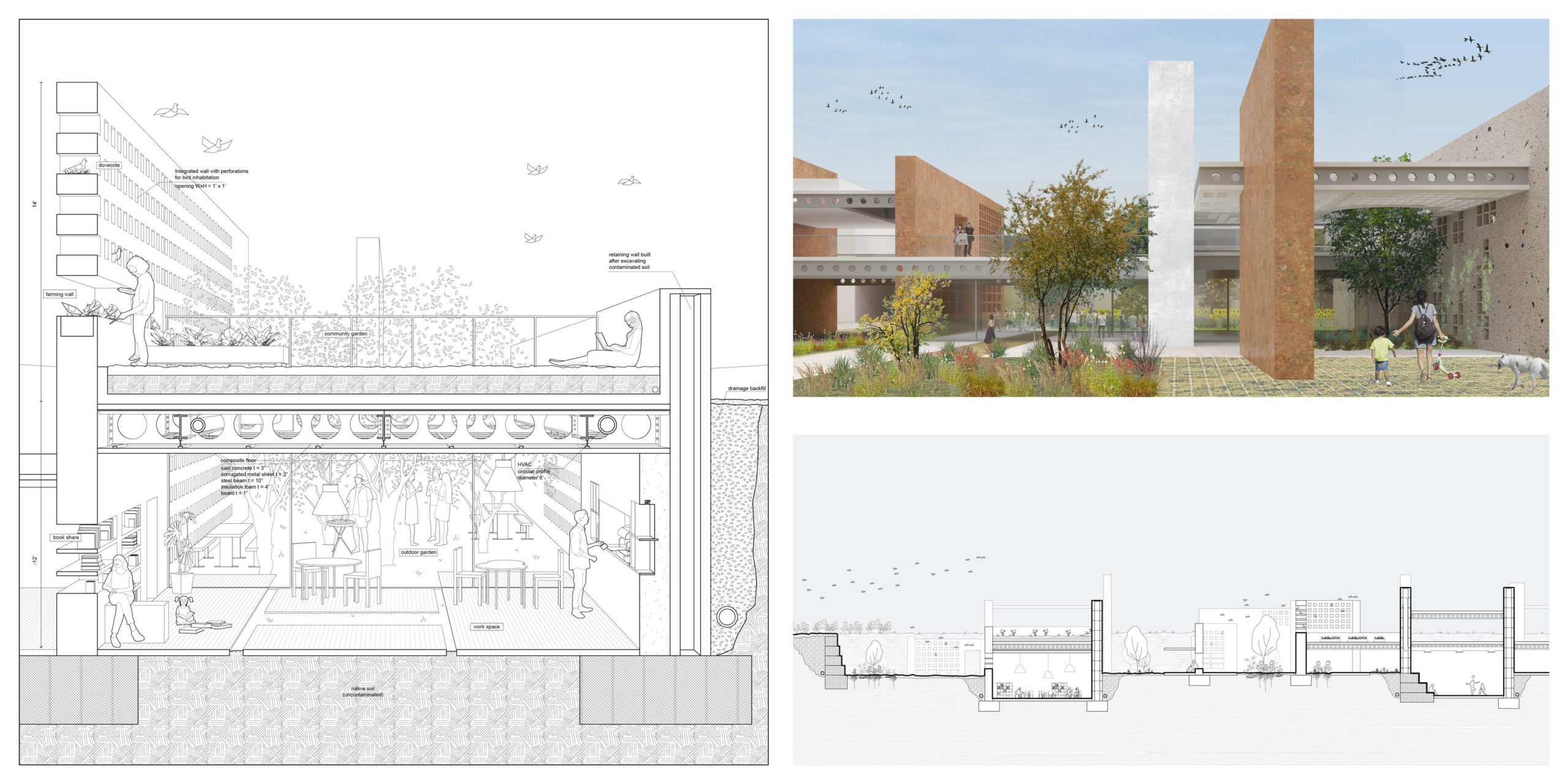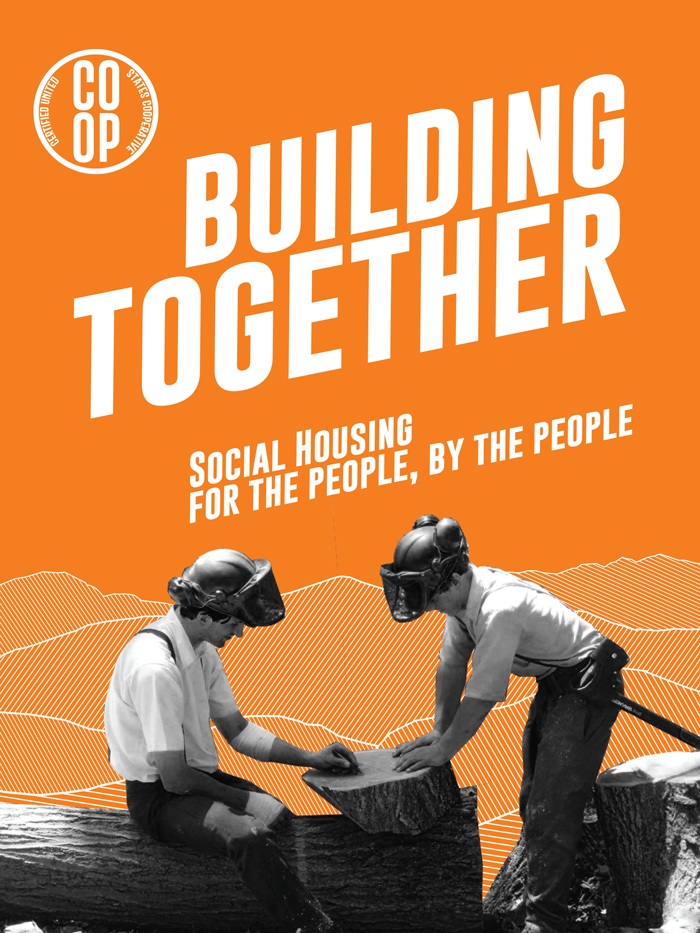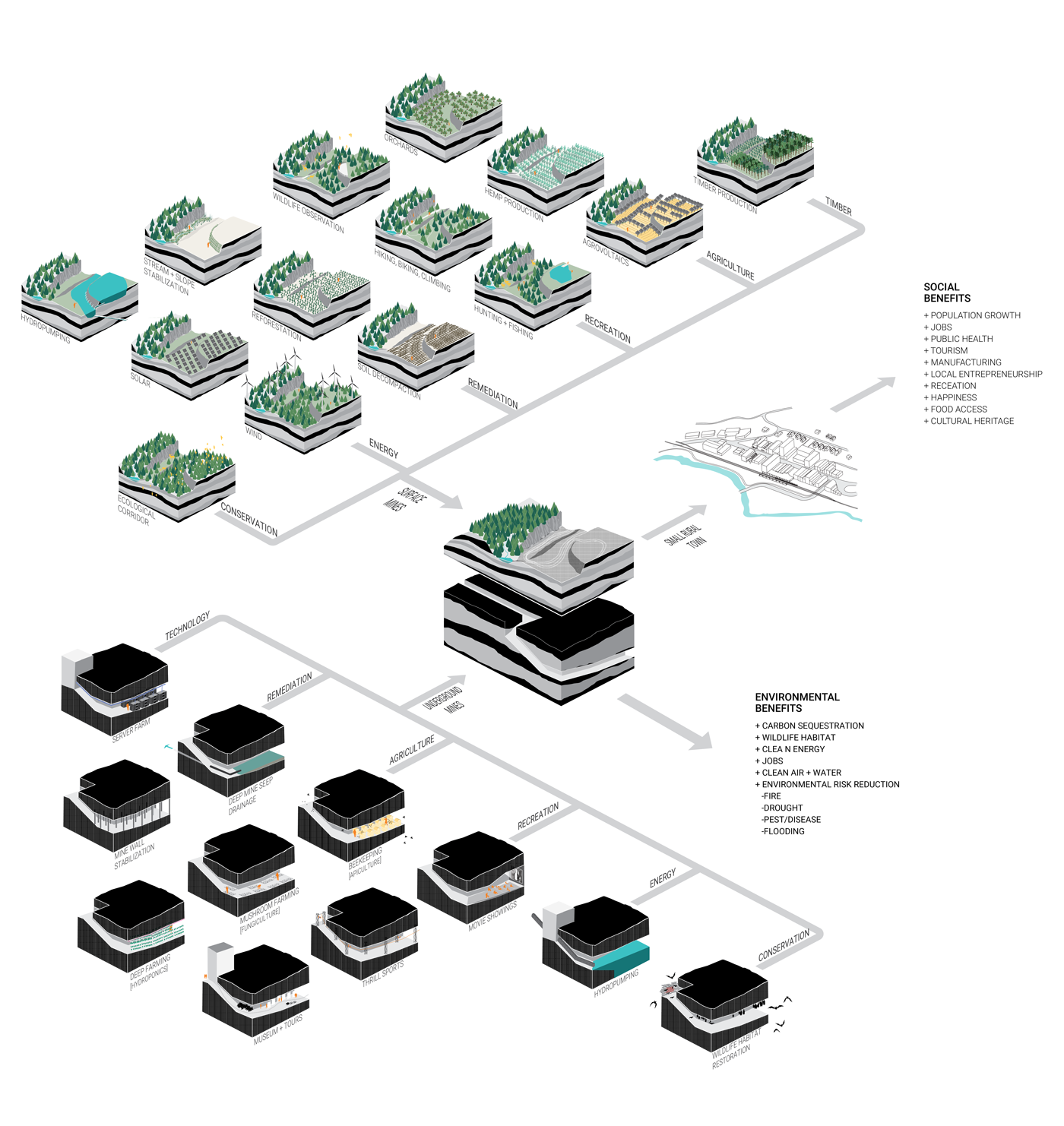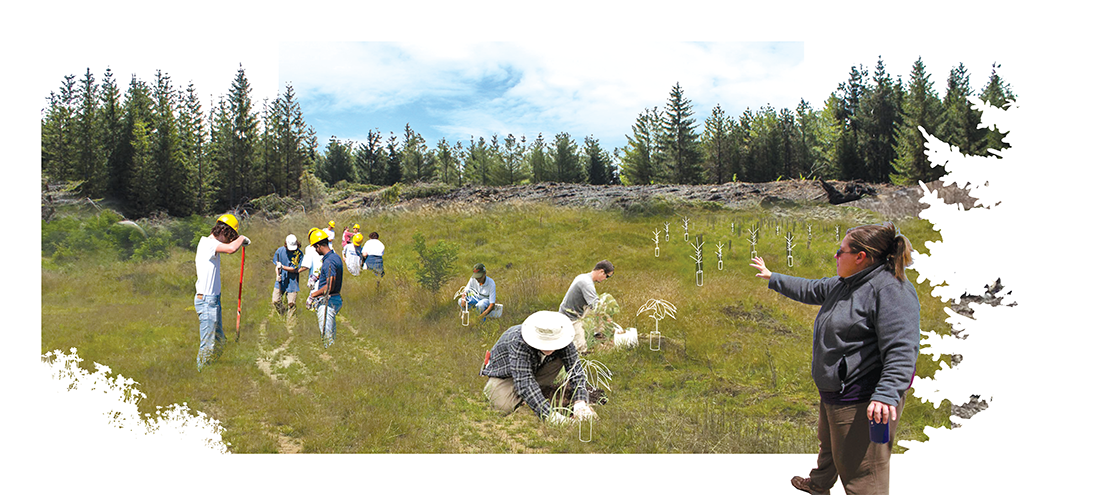Studio Reports
Student research and propositions from design studios with real-world implications.
We are celebrating 15 years — and counting — of stories that are deeply researched and deeply felt, that build a historical record of what the city has been.
Climate change has been consistently unfolding around us, permanently altering our world, and the disasters are only mounting. Proposals to abate the very worst outcomes require that we keep warming under two degrees Celsius. To do so, radical changes must be adopted. For architects entering the field, climate justice is an imperative that will inform how we continue to handle crises — both known and yet to be confronted.
The way we imagine, construct, and interact with buildings and infrastructure will determine if and how we cap rising temperatures in the coming decade. At the global scale, building materials, construction, and operations emit about 40 percent of greenhouse gas emissions annually. As wildfires consume landscapes and hurricanes displace communities, designers have begun to sketch out an expansive and imaginative vision to repair and rebuild the environment through a just transition that centers the communities of color most impacted by climate change. Beyond more solar panels and wind turbines, what will it look like?
In the words of Alexandria Ocasio-Cortez, “the first big step [is] just closing our eyes and imagining it.” The introduction of the Green New Deal to the US House of Representatives in 2019 energized conversations about what work must happen to curb the planet’s ongoing deterioration. The non-binding resolution calls for a ten-year plan to reduce the national carbon footprint, cutting emissions in half by 2030 and eventually reaching net-zero by 2050. Critically, the Green New Deal connects environmental recovery to social equity through programs that address the wealth gap, provide access to housing and education, and secure resources for low-income communities of color. Some cities, including New York, have passed climate legislation influenced by the Green New Deal, but the contours of the resolution are undefined, and details are still being debated. Grassroots organizations, students, and politicians have all surfaced different policy proposals and interpretations.
As the Green New Deal’s goals are translated into legislation, they must also be envisioned spatially. Many schools of design have begun to embrace the proposal’s radical call to reimagine landscapes throughout the US. Below, we survey some of the student work produced in the last year — the beginning of an exploration that challenges the scale and scope of architecture and landscape architecture. Initiatives to connect policy and spatial planning are expanding, with collaborative programs like a national Superstudio giving “form and visual clarity” to the Green New Deal now underway. With more to come, this first round of student work highlights the role architects can play in promoting decarbonization and social equity while, at the same time, engaging in conversations about rethinking the practice as a whole.
Pratt Institute professors Jason Lee and Meredith TenHoor asked students to first write a set of policies for a “Green New World,” then translate these policies to drawings and projects. This exercise in world-building encouraged students to dream of a utopian, just transition, where they explored issues such as accessibility, care, mobility, health justice, and decarceration. Some of the most prominent criticism of the Green New Deal has focused on how unrealistic it is, but speculating on the future of equity in the built environment means rethinking systems that currently exist. The challenge of the studio was to negotiate the role of the architect in a new system, one that translates the desires of the most vulnerable communities to design.
“We gave students free reign to imagine judicial rulings, executive orders, and/or legislation that had already been funded through a just transition, because we wanted them to be able to bring their desires for a more just world into being without having to imagine neoliberal systems financing such a transition.”
—Meredith TenHoor
Set after the Green New Deal has passed into law, Cory Breegle’s “Bed-Stuy Pocket Community” imagines a world where the Bedford-Stuyvesant community can take its land back from developers and establish local leadership to tackle the inequitable consequences of climate change and displacement. The pocket community is self-sufficient, powered by Small Modular Reactor (SMR) generators and urban farms. Decisions are made within the community, and any excess energy generated within the neighborhood is sold back to the city to power other neighborhoods. Social infrastructure includes agencies that provide access to healthcare, education, recreation, and technology.
Establishing a new municipal agency, the New York City Department of Public Assets, Emely Balaguera rehabilitated Rikers Island in order to heal the wounds created by mass incarceration. The imaginary agency works at the intersection of social and environmental equity, implementing policies for decarceration while providing new sites to engage with the site’s history of toxicity. In this world, the prison on Rikers Island is demolished; in its place, forests and wetlands are cultivated, remediating the ecology of the land and healing trauma embedded in this site of systemic injustice.
In the fall of 2019, Columbia GSAPP’s Temple Hoyne Buell Center assembled a series of architecture, urban design, and urban planning studios to explore the ambitions of the Green New Deal and begin a conversation about the social, political, cultural, and technical specificities of the resolution.
Bryony Roberts and her students explored the social contours of the Green New Deal, focusing on the ethics of care and its relation to sustainable ecological practices. The studio considered how universal access to childcare is needed to address gender, race, and class inequities. Working with Chhaya Community Development Corporation — a New York City community organization focusing on housing needs for South Asian and Indo-Caribbean communities — students proposed their own childcare facilities in Jackson Heights. The studio looked to the community land trust model as a way to address issues of gentrification and affordability.
“The course approached care from an intersectional perspective, seeing social issues of gender, race, class, and sexuality as intertwined with environmental justice questions . . . Rather than feeding into exploitative, extractive practices of capitalism and colonialism, how can architecture develop structures of care for both human and environmental systems?”
—Bryony Roberts
In “Childcare+,” Rui Wang imagined a combined childcare center and community garden that provides a new social infrastructure for the Jackson Heights community in underutilized spaces. The project explores the playground as a space for child development, and visualizes a new method for providing an outdoor recreational environment along a busy street. The first floor of the proposal is connected to the business corridor, while a food incubator is integrated with the gardens on upper floors, creating a childcare center that also serves the community in other ways.
In “Work Hard, Play Hard,” Emily Tobin responded to the question of equitable and universal childcare by integrating a childcare center within the workplace. Through “subtractions” from the building’s massing, the proposal incorporates public, outdoor green spaces, which serve the community and encourage interaction with the street corridor. Using a community land trust model, the project speculates on a future where a new social structure that supports children and working families can also address climate change and gentrification.
Recognizing the Green New Deal’s visionary scope, Marc Tsurumaki’s course articulated the resolution’s aspirations in relation to the sublime. Beyond imagining the form that specific policy initiatives would take, students were asked to visualize the context in which the Green New Deal would be operating 30 years from now. Examining climate change and social instabilities through a critical lens in order to understand the interdependency between “the human-made and the natural,” students were asked to select a subject in the Green New Deal’s resolution and develop their projects within the three-decade time jump.
“Fostering a social significance and cultural value at the scale of the Green New Deal requires a paradigmatic shift in how we think of ourselves in relation to the natural environment.”
—Marc Tsurumaki
Focusing on agriculture, Joud Al Shdaifat and Kathleen McNamara’s “Terra Vita” predicted a future where the New York City Department of City Planning establishes a “Zoning Resolution of 2035” in response to climate catastrophes directly linked to destructive agricultural practices. The proposed resolution rezones Manhattan to create “Mandatory Agricultural Production (MAP) Zones,” and mandates that historic preservation projects must also preserve the communities inhabiting these buildings. Terra Vita, a prototype historic preservation project located in a MAP zone, converts the existing Audubon Terrace in Washington Heights into an aquaponic agricultural production hub that provides food and shelter to residents, and access to public space for others in the neighborhood. In addition to food production, the site uses homeostatic systems to circulate water, filter out waste, and repurpose energy. The goal of the project was to create resilient infrastructures that could simultaneously combat gentrification and preserve the diversity of Washington Heights.
In “New Futures and the Wasteland,” Brenda Lim and Andrew Keung explored toxicity and remediation through an imaginary intervention at the National Grid Liquid Gas Holding Facility in East Williamsburg. Instead of seeing remediation infrastructure as static, the project posits it as a substrate for future programming. Three remediation strategies are applied to the site: phytoremediation, in-situ chemical oxidation, and excavation. The infrastructural artifacts resulting from these strategies are then used as the basis for landscapes that might reintroduce both human and non-human species to the site and allow for cohabitation.
In the spirit of other civil society programs such as the Civilian Conservation Corps and AmeriCorps, David Benjamin and his students were committed to imagining architecture’s response to the climate crisis as a public service by way of a proposed Climate Design Corps. Working within this framework, students had the freedom to choose their own site and establish a project and program, while analyzing their proposals’ impacts over the course of eleven years. Rather than looking at architecture as fixed objects, students worked with the notion that architecture is an open system. Given that low-carbon building largely means working with what already exists, the challenge was to “design buildings for disassembly.” The projects were distributed across a spectrum of sustainability measures, from temporary structures that can be adapted for multiple uses, to buildings designed for durability using low-carbon materials. In tackling the Green New Deal’s radical goals for building infrastructure, the studio also carried out urgent conversations around the architectural profession and its hierarchies.
“We were asking: How can you design a specific building as a prototype, but also keep in mind its broader impact?”
—David Benjamin
Using adaptation and mitigation principles, “High Time for Low Tech” is Julia Pyszkowski’s proposal for low-density urban and suburban areas that will be susceptible to dry, desert-like weather by the end of the century. Exploring durability and flexibility, Pyszkowski prototyped a two-family home and mid-rise apartment building. The structures are built with brick, a material that will evolve as technology advances. The prototypes also account for increasing heat by having buffer layers which can be shed, including an outer greenhouse layer that can be used for agricultural production in a future where limited water supplies and dry air will make it challenging to grow crops. As the buildings’ buffer layers are removed and utilized, household activities adapt and move inward. With the climate crisis constantly evolving, this project seeks an open-ended, adaptable strategy for circumstances as yet unknown.
Qi Yang looked at the role architectural labor plays in decarbonization through their project, “Mass Innovation.” In addition to designing more resilient structures moving forward, all existing buildings will need to be retrofitted to cap rising temperatures. Based on the current labor system in the United States, this task is impossible; there are simply not enough architects practicing with a license. This project proposes establishing a new architectural accreditation and licensure process which breaks down licenses into three different categories according to levels of expertise. The new system makes architectural knowledge open source by allowing different levels of architects to mobilize sustainability at new scales. “License A” architects research sustainable practices for climate zones and provide recipes to “License B” architects, who develop design proposals through material research and new construction processes. Finally, “License C” architects (although they are not specialized) can carry out renovations to existing buildings.
At the University of Pennsylvania, Billy Fleming’s “Designing a Green New Deal” studio focused on the national scale by first identifying which regions should be prioritized for public investment. Acknowledging that political and natural boundaries do not operate at the state level, students focused on Appalachia, the Mississippi Delta, and the Corn Belt of the Midwest — three sites of historic disinvestment —restructuring these communities through material and financial transformations to buildings, landscapes, public works, and infrastructures. Students spent time exploring the legacy and strategies of the original New Deal to better understand the scale of their approach. The goal of the studio that was to engage with the Green New Deal as a collective and collaborative project rooted in new visions of community and economic development.
“We didn’t want our students to produce the kinds of fantastical images of a future no one outside of Silicon Valley or a corporate boardroom would ever truly desire. Instead, we asked them to connect their visual work to a theory of change, and to produce a set of images related to the material transformation of everyday life — not through some yet-to-be imagined technology or yet-to-be-realized communitarian revolution, but through what we came to call the ‘big strategic levers’ of the built environment.”
—Billy Fleming
Working with the history of Appalachia as a site of energy production, Allison Carr, Zachery Hammaker, Sara Harmon, Tiffany Hudson, and Joshua Reaves reimagined the area as a stronghold for clean energy production controlled by communities through cooperative ownership. Beyond economic revitalization, the project looked at radical change for the area through Green New Deal policies for regional self-sovereignty. The students found that the region’s urban areas are growing, particularly its Latinx and Black communities. This led to conversations about how to use existing infrastructure to create hubs that put these communities first. The project repurposes coal mines for food and energy production, and flattens mountaintops for recreational space. New buildings are carbon-neutral, and existing structures are retrofitted. In addition to energy, the project looks at transportation through rail lines that connect smaller towns to growing urban areas. Prioritizing Appalachia as a whole, as opposed to a single city, the students sought to challenge our current political systems, looking at long-term investments that equalize communities across different landscapes.
Historical parallels to the New Deal formed the basis for University of Pennsylvania students in Nicholas Pevzner’s design seminar to explore the backstory of how we get to a “Green New Future.” Students developed written and visual narratives from the future that detail the transition into a just and equitable society. Students were asked to look at the “spatial potentials” of the Green New Deal, by identifying concrete changes that it might facilitate between the landscape and the built environment. New renewable energy landscapes, low-carbon industries, and community-oriented facilities for job training, education, and material restoration emerged from the studio. These visions redefined relationships to our material reality by imagining radical investments in a low-carbon economy and testing “just transition” practices rooted in regenerative landscapes: agriculture, electric transportation, coastal adaptation, and low-carbon housing.
“What is at the edge of the possible? Instead of an unachievable utopia, we created positive visions for decarbonizing the built environment and creating green jobs with a focus on justice that is still grounded in political realities, but gets us toward fundamental system change.”
—Nicholas Pevzner
Through the development of a New Stewards curriculum, Chyanne Eyde imagined the future of national education in 2030. The proposed program and posters detail a curriculum built around ideas of environmental resilience and self-sovereignty. In this scenario, the teacher activists who develop the original New Stewards curriculum seek to involve the many stakeholders around schools, including parents, in environmental stewardship, while the expansion of publicly-funded early education programs enables children as young as three years old to learn about decarbonization and the significance of sustainability. While climate and political instabilities have closed off parts of the world, there is a commitment to protecting the environment across levels of society. This project argues that potential for environmental progress starts in Pre-K and extends throughout educational practices that cultivate like-minded peers.
As part of a new, “cyborg” world, Ira Kapaj visualized energy infrastructure in the heart of the city. In this project, questions of energy use and access are transparent and brought into the public realm — instead of storing energy offsite, the proposal argues that green infrastructure must be an integral part of the urban context. Here, the wind turbine becomes an “infrastructural artifact” that is both site-specific and part of a distributed system. Beyond its utilitarian function, the turbine is mobilized to establish a narrative about the built environment in a world where technology and policy are visible and constantly evolving, much like the city itself.
The views expressed here are those of the authors only and do not reflect the position of The Architectural League of New York.
Student research and propositions from design studios with real-world implications.


